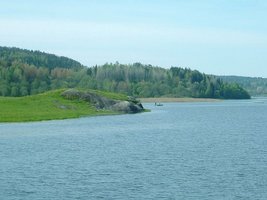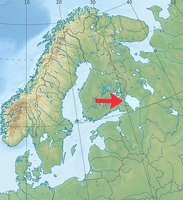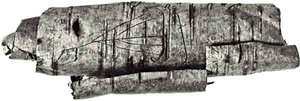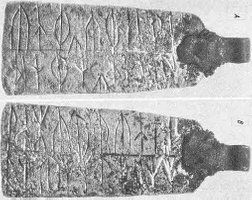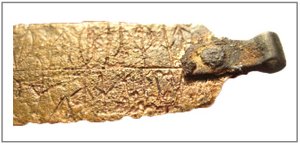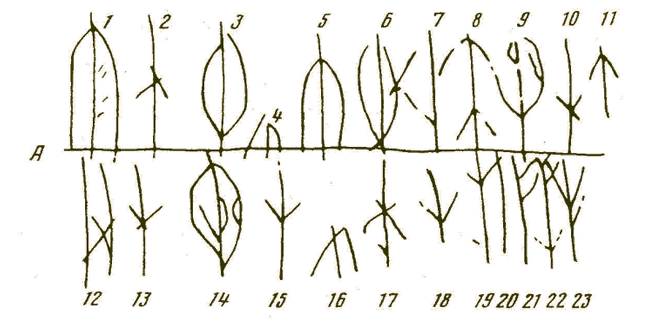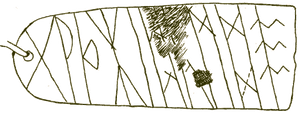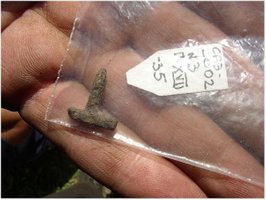The blog of this week is written by Valentin Sustov from Russia.
Aldeigjuborg – the first Russian capital.
Aldeigjuborg, or, in Russian, Staraya Ladoga is probably the oldest city in the northern part of Russia. It was founded near 750 B.C by Scandinavians (perhaps by Vikings from the island of Gotland) and shortly afterwards became prosperous.
Dating of Aldeigjuborg
The first buildings in Aldeigjuborg, due to archaeological studies, were built at Zemlenoe settlement of the wood, which had been cut down before 753 B.C (according to tree-ring dating studies). That’s why the dating of Aldeigjuborg lies down within the limits of the middle of the 8th century B.C. The buildings were ship-repair workshops and forges. But in 2013, archaeologists found a Frankish comb of the 7th century B.C and some other founds which were dated before the year of 750 B.C. And nevertheless scholars believe, that the Aldeigjuborg was founded near 750 B.C, because these artifacts could be a simple Viking trophies, which were held in their families.
Short history
The first dwellers from Aldeigjuborg were Scandinavians - the colonists and Finns from nearby tribes. The Slavs begin to penetrate this territory in the end of 60th of the 8th century. They captured some territory from Finnish tribes and built some fortifications in the Ladoga region. These actions led to military conflict between Vikings, Slavs and Finns. In the end of 60th Slavs destroyed Aldeigjuborg and rebuilt the area in a Slavic way. The new "authorities" of Aldeigjuborg began to start up a large-scale trade. Archaeologists found the treasure of Arabic dirhams, which was dated 786 B.C.
In the beginning of the 30th of the ninth century Vikings reconquered the city and, due to controversial theory, established the state, which is customary called Rus’ Khaganate. This time period is characterized by a climax of trade. Nowadays archaeologists find beautiful Scandinavian jewelry, Greek beads, Finnish ceramics, Arab coins and rings, Khazar glass, Slavic crockery and more. But it had to end. Aldeigjuborg was destroyed again in 860-862 during the civil war between various ethnic groups, which lived in the Ladoga region.
In 862, the dwellers of Aldeigjuborg (due to chronicles they were Slavic and Finnish tribes) «invited» Rurik to rule them, because of large number of civil conflicts and decentralized authority. Rurik came to Rus’ with his brothers – Sineus and Truvor and with his own army. The future Russian ruler, Oleg (Helgi) was a member of Rurik’s inner circle. Sineus settled at Belo Ozero and Truvor at Izborsk (some archaeologists stands, that he settled in Pskov). After their deaths, Rurik became a supreme ruler of Rus’ and moved his residence to Holmgarðr (Novgorod) in 864.
On the following images some intruiging artefacts, found in this area..
Viking ship image carved in bark scroll 10th century
Runic amulet made of copper IX-X century and same amulet colour imaga (right)
Glass beads
Sketch of runcic amulet made of copper IX-X century (see photos above). The interpretation of the inscription is missing and attempts to read it has not been done. We only know, that the amulet has these words on it: unþR (1–4), runaR (29–33), and probably þaR (14–16) and haki or hak (17–20).
Horodyshche amulet - sketch of front and back side.
The first side consists of 4 Elder Futhark runes and one cryptography sign. The others are short-branched runes. The second side consists of Younger Futhark runes and cryptography symbols. This amulet is probably of Icelandic origin and the interpretation of the inscription is derived from Old Icelandic - Varr í fárland — is being protected [on the road] in a dangerous land or varr í farland — protected during a sea voyage", "protected" [on the road] to a distant land. Due to the last runes the owner of this amulet was "protected" by a god Týr. The second side of the amulet consist of one inscription - þarnisk þér eigi u (úrr), what it means - Yes, You will not be deprived of male power.
"Horodyshche amulet II" which has not been translated yet.
Thor hummer amulet from Ladoga-Aldeigjuborg X century
Well. I could have been with these stones until after dark, but as my wife wanted to travel on.. well.. I see you again, some day, hogback stones from Gosforth. And if you happen to be there one day, do not forget that monument on the outside...
Further on with the Cumbrian hogbacktour !
In - yes, luckily again in - St. Peter's church in Heysham, there is a truly beautiful hogback stone. The guide told us, it had been studyied by Thor Ewing, a writer, in 2000. in 'Understanding the Heysham hogback' A tenth century sculpted stone monument and its context (link), Thor Ewing tells in detail what he dicovered on the both sides of this hogback stone.
Just being brought in the church as late as the 1970's accompanied with some protest here and there among the church visitors, considered as being a token of old paganism, it had been remarkably nice preserved, and a lot of detail can be seen, still. Truly worthwile a visit.
I had a small debate with the guide in the church if the - zoomorphic, in my opinion - faces on the sides were lions (or hippo's). The guide doubted if the vikings could have known about lions. Well I guess so, concerning the runes on the Ancient Greek lion statue at the Arsenal, Venice. For example. Vikings did travel south..
But when he told me he was doubting the vikings 'discovered' (as the native inhabitants were of course, in the first place) America before Columbus, I decided to rest my case..
One has to know when to start and to end a conversation ..
Just discovered the book in a bookstore written by Geoff Holder - The guide to the mysterious Lake District, I knew there had to be another hogback stone in Lowther, St. Micheal's Church. With a promising image described in the text of 'a naval and a land-based force of shield-bearing vikings above a fish and what might be a coiled sea serpent. On the reverse is a row of female figures with snakes, possibly a representation of the hideous hag Hel'. Wow. If that did not sound as a true pagan promised land ..
Not complaing too much after all we have seen, this visit was the dissapointing one of them all. But if you wife states 'I am happy to have seen them' and I am answering 'Measuring is knowing' and the even more obligate verb 'handling 'if we did not see it at all, we wouldn't have known anything at all of how they were looking' the glass was again half full, at the last day of our journey..
The hogback stone appeared to be just being tolerated within the entrance segment part of the church. As something you never use anymore but you do not throw away - entirely. That sort of feeling emerged when seeing this hogback asylum seekers.. Bed, bath and bread, ás we say in Dutch, but no luxury at all and standing on some outcuts of wood, you would balance the table with at home..
Come on, St. Micheal's Church.. care a bit more of your 'children' !
This hogback stone was moved in the church in 1907. Hogback stones layed partially buried in the churchyard before it was dug up and moved into the church.
The promising depiction of a longship - as certainly can be seen after some studying - see http://vikingminds.co.uk/pages/longship
we have missed !
The stone itself is (157 x 50 x 30 cm) and very worn.
The hogback stones in Cumbria - very diverse in quality, but everyone worth a visit ! Especially on a gloomy day in late October ...
The churches to visit - see photos of resp. St. Andrew's church in Penrith, St. Mary's church in Gosforth, St. Peter's church in Heysham and St. Micheal's church in Lowther.
Did I miss out on another one in Cumbria ? Let me know !
In a next blog I will take you to four - still remaining utterly mysterious- statues 'guarding' the graveyard of St. Andrew's church in Dacre..
For the last blog of October 9th see this link.
References: (as always, links to where the books can be ordered are attached).
Edwards, B.J.N. Vikings in North West England - The artifacts (1998);
Emery, Gordon, CURIOUS CUMBRIA, The Lake District & Beyond: A celebration of Cumbria (2023)
Ewing, T. 'Understanding the Heysham hogback' A tenth century sculpted stone monument and its context ;
Hall, R. Viking Age archaeology in Britain and Ireland (first printed 1990, reprinted with amendments in 1995);
Holder, G. The guide to the mysterious Lake District (2009)
possibly also (as there within the part of Cumbria dealing with Carlisle, the Eden Valley, Barrow-in-Furness, Whitehaven and the west coast is being dealed with)
Holder, G. Paranormal Cumbria (2010)
http://vikingminds.co.uk/pages/longship
The first image is bark scroll of the 10th century with a Viking ship image on it. It was found in Ladoga-Aldeigjuborg in 1984 by A.N. Kirpichnikov. He made this photo in 1984 and published it in Russian historical magazine Nashe Nasledie (Our Heritage) in #106 of 2013 edition.
The fourth photo shows the glass beads, but who made them - its a subject of dispute (Vikings, Finns, Slavs or others). The Russian science claims their Slavic-Finnish origin.
The main source of Valentin Sustov were the works of famous Russian archaeologist A.N.Kirpichnikov
Additional note and reference of myself:
See for the subject of dispute where artefacts in Russia originated from and one of the best books having been written on the presence of Scandinavians in Eastern Europe (attached as link)
Wladyslaw Duczko, Viking Rus: Studies on the Presence of Scandinavians in Eastern Europe, 2004
Link to blog March 27th 2015
